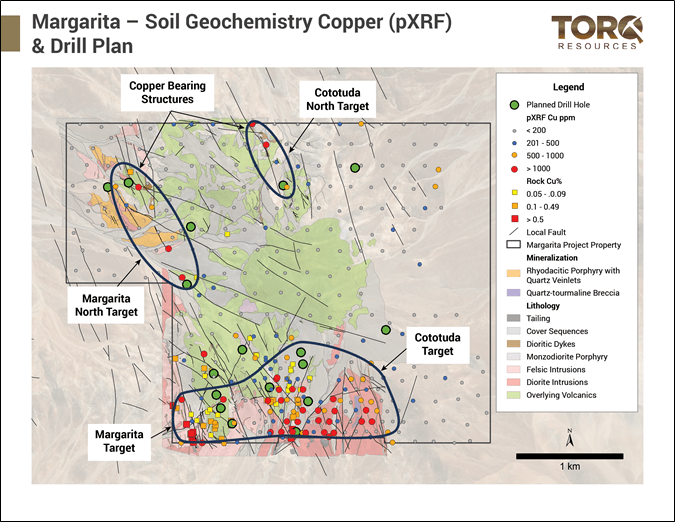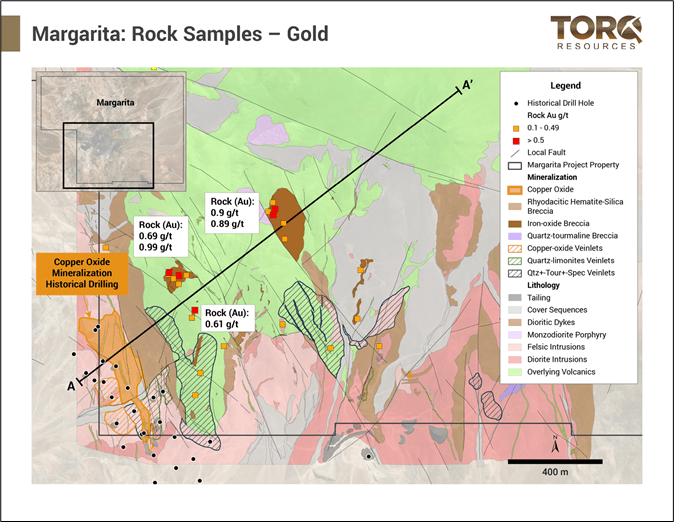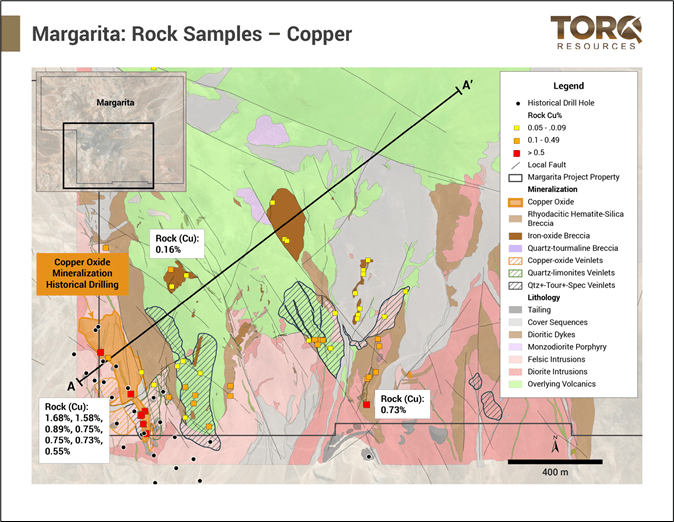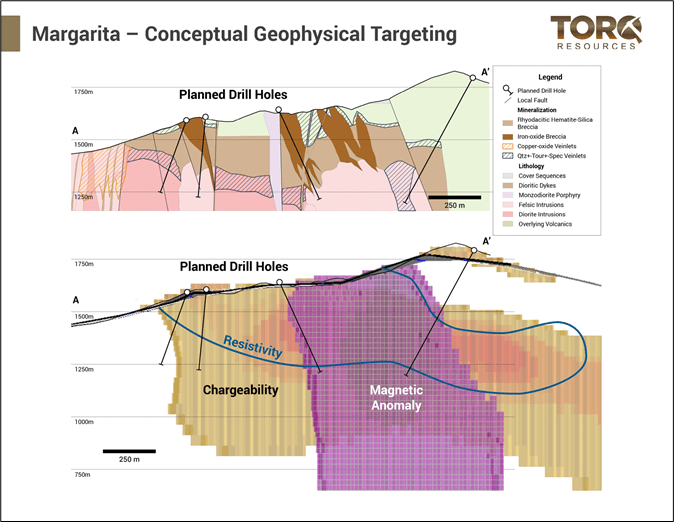Torq Defines Drill Targets at the Margarita Copper-Gold Project in Chile
VANCOUVER, BC / ACCESSWIRE / September 8, 2021 / Torq Resources Inc. (TSXV:TORQ)(OTCQX:TRBMF) (“Torq” or the “Company”) is pleased to announce that it has identified three primary target areas at the Margarita Iron-Oxide-Copper-Gold (IOCG) project in northern Chile that form the basis for the upcoming 4,000 metre (m) reverse circulation (RC) drill program, slated to begin later this month (Figure 1). The targets were defined using data from recent geophysical and geochemical surveys as well as a geological mapping program.
A Message from Shawn Wallace, Executive Chairman:
“The refinement of drill targets at the Margarita project has our entire team excited about the prospectivity of the project and the real opportunity to make a major new discovery in one of the best jurisdictions for mining on the planet. We are anxiously awaiting the commencement of our drill program later this month. Furthermore, the Company is very pleased with the progress being made in the planning for the Andrea project, with work anticipated to commence in early 2022.”
Exploration and Drill Targeting Update:
Torq has identified three primary target areas across the project area based on the completion of 1:2000 scale geological mapping, soil (pXRF) and rock geochemical sampling programs, and ground-based induced polarization and magnetic geophysical surveys. Geologically, the property can be broadly defined by a large-scale intrusive complex that is interpreted to be directly associated with copper-gold mineralization and by an overlying volcanic sequence that is mineralized along discrete north-northwest structural trends (Figure 2).
A Message from Michael Henrichsen, Chief Geologist:
“The Margarita project is characterized by geological features that are consistent with both IOCG and porphyry systems. The strong presence of copper oxide and gold mineralization within well-defined structural corridors that are coincident with chargeability highs and resistivity lows provides an opportunity for a major discovery at the project and we are very much looking forward to our first drill program.”
Southern Targets:
The southern Margarita – Cototuda target area is characterized by a large scale 1.5 kilometre (km) by 500 m copper in soils (pXRF) geochemical anomaly that is hosted within a largely dioritic to dacitic intrusive complex (Figure 2). Copper oxide mineralization is observed both within various intrusive phases as disseminated stockwork vein zones and concentrated along the north-northwest trending Margarita and Cototuda structural trends, where shallow historical drilling has reported copper oxide mineralization within 100 m of surface (historical drilling not compliant with National Instrument 43-101). Alteration associated with the broad zone of mineralization is characterized by strong sericitic-hematite alteration with lesser potassic alteration observed within the Cototuda area.
Rock sampling within the alteration zone from this area has identified copper oxide mineralization with values up to 1.68% copper and up to 0.99 g/t gold within silica-hematite breccia bodies that occur parallel to the strong north-northwest structural trends observed within the target area (Figures 3 – 4). Rock sampling highlights are presented below in Table 1. Finally, the southern target areas are characterized by chargeability highs indicating the presence of sulphide, resistivity lows indicating hydrothermal alteration and magnetic anomalies that may be related to magnetite-copper sulphide mineralization (Figure 5).
Northern Targets:
The northern target areas are situated along the extensions of the Margarita and Cototuda north-northwest trending structures and are defined by copper in soils (pXRF) geochemical anomalies. The Cototuda North anomaly is hosted entirely within the volcanic sequence that overlies the mineralized intrusive bodies observed in the southern target area. Torq’s technical team believes that there is strong potential to encounter mineralized intrusive bodies within this structural corridor based on the presence of chargeability highs, indicating the potential for sulphide mineralization, and resistivity lows, indicating the presence of hydrothermal alteration at shallow depths of approximately 150 – 300 m. The Margarita North anomaly is hosted at the sub-horizontal contact between the volcanic sequence and underlying rhyodacitic and diorite intrusions. Strong sericite-clay-tourmaline alteration has been observed at the base of the intrusive bodies, passing upward to silica-hematite-pyrite alteration located within the volcanic sequence. In addition, strong resistivity lows, indicating intense alteration, are situated at shallow depths of approximately 150 m.
Table 1: Margarita – Cototuda target area selective rock sampling highlights
|
Sample ID |
Cu (%) |
Sample ID |
Cu (%) |
Sample ID |
Au (g/t) |
Sample ID |
Au (g/t) |
|
1424 |
1.68 |
1465 |
0.25 |
1439 |
0.99 |
1440 |
0.16 |
|
1423 |
1.58 |
1469 |
0.22 |
1449 |
0.90 |
1504 |
0.15 |
|
1420 |
0.89 |
574666 |
0.21 |
1463 |
0.89 |
1429 |
0.15 |
|
574654 |
0.75 |
1399 |
0.20 |
1432 |
0.69 |
1435 |
0.14 |
|
1422 |
0.75 |
10009 |
0.19 |
1443 |
0.61 |
1451 |
0.12 |
|
1412 |
0.73 |
1473 |
0.16 |
1447 |
0.49 |
1488 |
0.12 |
|
1421 |
0.73 |
1431 |
0.16 |
1399 |
0.46 |
1553 |
0.12 |
|
574656 |
0.55 |
1467 |
0.15 |
1433 |
0.27 |
1464 |
0.12 |
|
1498 |
0.38 |
1511 |
0.14 |
1457 |
0.24 |
1508 |
0.11 |
|
1403 |
0.34 |
10002 |
0.14 |
1480 |
0.22 |
1571 |
0.10 |
|
1575 |
0.33 |
1496 |
0.12 |
1409 |
0.20 |
||
|
1508 |
0.28 |
1475 |
0.11 |
1570 |
0.18 |
||
|
1468 |
0.28 |
1570 |
0.10 |
1438 |
0.17 |
||
|
1569 |
0.26 |
1476 |
0.10 |
1446 |
0.17 |

Figure 1: Illustrates the location of the Margarita project within the Coastal Cordillera belt and its proximity to major deposits in the region.

Figure 2: Illustrates the location of the primary targets at the Margarita project. Note the southern target area is comprised of the Margarita and Cototuda target areas that are characterized by abundant copper oxide mineralization on surface over a 1.5 km by 500 m area within dioritic to dacitic intrusive bodies. The target areas to the north are situated along north-northwest structural trends that are interpreted to be the extensions of structures at the Margarita and Cototuda target areas.

Figure 3: Illustrates gold mineralization within the southern target areas. Gold in rock samples are contained in zones of silica-hematite breccia bodies and are considered consistent with iron-oxide-copper-gold mineralized systems.

Figure 4: Illustrates copper oxide mineralization from rock samples within the southern target area that are characterized by zones of stockwork veining.

Figure 5: Illustrates geological and geophysical cross sections from the southern target areas of Margarita and Cototuda where targets are characterized by geophysical characteristics of chargeability highs, indicating the presence of sulphide minerals, resistivity lows, indicating hydrothermal alteration, and magnetic highs, indicating the potential for magnetite – copper sulphide mineralization.
Michael Henrichsen (Chief Geologist), P.Geo is the QP who assumes responsibility for the technical contents of this press release.
ON BEHALF OF THE BOARD,
Shawn Wallace
Executive Chairman
For further information on Torq Resources, please visit www.torqresources.com or contact Natasha Frakes, Vice President of Communications at (778) 729-0500 or [email protected].
About Torq Resources
Torq is a Vancouver-based copper and gold exploration company with an established portfolio of premium holdings in Chile. The Company was built by a management team with prior success in monetizing two well-known exploration companies. Torq is further supported by a specialized technical team, recognized for their expertise and experience working with major mining companies. This includes the Company’s Chile-based technical team with a noteworthy track record for major discovery in that country. Torq’s invaluable local expertise has provided the leverage and connections for the Company to continue to acquire and explore highly prospective assets in the pursuit of a landmark discovery. For more information, visit www.torqresources.com.
Chile Rocks 2021 (Margarita)
Approximately 2-3kg of material was collected for analysis and sent to ALS Lab in Copiapo, Chile or La Serena, Chile for preparation and analysis. All samples are assayed using 30g nominal weight fire assay with ICP finish (Au-ICP21), multi-element four acid digest ICP-AES/ICP-MS method (ME-MS61), and copper sulphuric acid leach with AAS finish (Cu-AA05). Where MS61 results were greater or near 10,000 ppm Cu the assay were repeated with ore grade four acid digest method (Cu-OG62). QA/QC programs for 2021 rock samples using lab duplicates, standards and blanks indicate good accuracy and precision in a large majority of standards assayed.
pXRF soil samples were collected under the supervision of Torq geologists in the field. At the proposed sample location, holes were dug to expose the B horizon (generally 30cm depth). B-horizon material was sieved passing #30 mesh to collect approximately 200 g and placed in marked sample bags. Sample site location and description were collected digitally in the field. Sample material was dried at a field lab and a split was placed in covered pXRF cups and labelled with sample ID. pXRF analysis were taken on the cups at the field lab using 3-beam 60 second soil mode on an Olympus Vanta M series unit. QA/QC measures included field site duplicates as well as regular pXRF analysis of standards and blanks at the field lab. At the beginning of the sampling program, a calibration curve correction for the Vanta pXRF unit was determined through analysis of reference material and subsequently applied to all sample analysis of the program.
Forward Looking Information
This release includes certain statements that may be deemed “forward-looking statements”. Forward-looking information is information that includes implied future performance and/or forecast information including information relating to, or associated with, exploration and or development of mineral properties. These statements or graphical information involve known and unknown risks, uncertainties and other factors which may cause actual results, performance or achievements of the Company to be materially different (either positively or negatively) from any future results, performance or achievements expressed or implied by such forward-looking statements.
Neither the TSX Venture Exchange nor its Regulation Services Provider (as that term is defined in the policies of the TSX Venture Exchange) accepts responsibility for the adequacy or accuracy of this release.
SOURCE: Torq Resources Inc.
View source version on accesswire.com:
https://www.accesswire.com/663136/Torq-Defines-Drill-Targets-at-the-Margarita-Copper-Gold-Project-in-Chile





